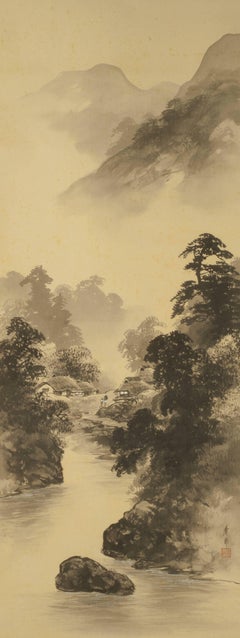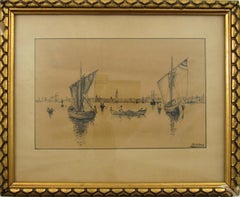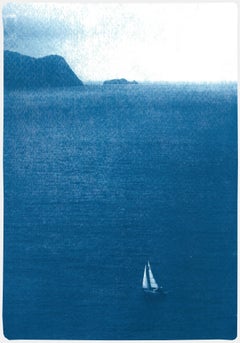Hijikata Torei Art
to
1
1
1
Overall Height
to
Overall Width
to
1
1
1
1
1
1
1
6,886
3,210
2,514
1,217
1
1
Artist: Hijikata Torei
Mountain Landscape
By Hijikata Torei
Located in Fairlawn, OH
Ink and gold on paper silk mounted to hanging scroll
Brush wash scroll
Signed Torei sha, sealed Hirokuni and Torei
Painting size: 42 x 16"
Scrol...
Category
Hijikata Torei Art
Materials
Sumi Ink
Related Items
Gustav Melcher ( German, 1898 -?) Boats off Venice Italy Ink Water Color c. 1918
By Gustav Melcher
Located in Meinisberg, CH
Gustav Melcher
(German, 1898-?)
Segelschiffe vor Venedig - Sailing ships off Venice
• India ink, water colour wash
• Visible image ca. 11.5 x 18 cm
• Glased Frame ca. 20 x 25 cm
• Verso various inscriptions
• Signed lower right
Gustav Melcher was a German painter and a pioneer in film, film criticism and film theory and created this clever little picture of the skyline of Venice with various vessels.
Going by the various inscriptions an the backing paper, this drawing was made in 1918 when Gustav was twenty years old and passed on three years later to Gertrud Melcher on the 1. 2. 1921. I have no reasons to doubt this information. The small drawing is still in its unopened frame, so maybe there is more information to be discovered , however this will be the privilege of the next owner.
The picture also has retained its original antique frame – note that it has lost over the years various sections of the gesso decoration.
The very precisely executed drawing is most enjoyable to look at and doing so, remember you are looking through the eyes of a young man, who saw this foreign sea cape over a century ago.
Thank you for your interest and please note, that I offer free worldwide shipping on all my items.
Gustav Melcher began his studies at the Düsseldorfer Kunstakademie under Peter Janssen and Eduard von Gebhardt. Originaly he was interested in figurative and portrait painting, but after time he decided to pursue the depiction of land- and marinescapes. Durin his studies the young artist undertook trips to visit England, Scotland, Belgium and France and he joined the artist society Malkasten. It was in those days he would hold speeches to his colleges about this new invention called ‘Kintopp’ – Melcher was a great advocate of the moving pictures...
Category
1910s Naturalistic Hijikata Torei Art
Materials
India Ink, Paper, Watercolor
Gustav MelcherGustav Melcher ( German, 1898 -?) Boats off Venice Italy Ink Water Color c. 1918, 1918
Free Shipping
H 7.88 in W 9.85 in D 0.79 in
Sailboat Journey, Nautical Cyanotype Print on Watercolor Paper, Indigo Seascape
By Kind of Cyan
Located in Barcelona, ES
This is an exclusive handprinted limited edition cyanotype.
"Misty Sailboat Journey" is a handmade cyanotype print portraying a daytime sailboat journey...
Category
2010s Modern Hijikata Torei Art
Materials
Marble
Costa Rica Beach Foam, Shoreline Seascape, Minimal Blue, Limited Edition Print
By Kind of Cyan
Located in Barcelona, ES
This is an exclusive handprinted limited edition cyanotype of a Sandy Shore with Foam.
Details:
+ Title: Sandy Shore with Foam
+ Edition Size: 100
+ Stamped and Certificate of Aut...
Category
2010s Realist Hijikata Torei Art
Materials
Marble
Original Set-Breakfast with Cat Series-British Award Artist-Gold, ink on papers
Located in London, GB
These two drawings as a set, encapsulate the enchanting moments experienced during a series of breakfasts at Shizico Yi's Scotland home. Created plein air and in situ, these scenes u...
Category
2010s Contemporary Hijikata Torei Art
Materials
Gold
H 16.54 in W 23.63 in D 0.04 in
Pavilion with waterfall, an ink wash attributed to Hubert Robert (1733 - 1808)
By Hubert Robert
Located in PARIS, FR
This large wash drawing is a slightly enlarged version of a composition executed by Hubert Robert in 1761, at the end of his stay in Rome. This composition is a marvellous synthesis of the painter's art: the clatter of the waterfall, in a grandiose setting inspired by antiquity, is opposed to the intimacy of a genre scene, made up of a few peasant women performing some agricultural work.
1. The stay in Italy, an important founding stage in Hubert Robert's carrier
Hubert Robert came from a privileged family of Lorraine origin, linked to the Choiseul-Stainville family, where his father was an intendant. The protection of this powerful aristocratic family enabled him to study classical art at the Collège de Navarre (between 1745 and 1751). After a first apprenticeship in the workshop of the sculptor Slodtz (1705 - 1764), he was invited by Etienne-François de Choiseul-Beaupré-Stainville (the future Duke of Choiseul, then Count of Stainville) to join him in Rome when the latter had just been appointed ambassador.
Hubert Robert arrived in Rome on 4 November 1754, aged twenty-one, and remained there until 24 July 1765. Thanks to his patron, he obtained a place as a pensioneer at the Académie de France without having won the prestigious Prix de Rome. On his arrival in Rome, he frequented the studio of the painter Giovanni Paolo Panini (1691 - 1765), the inventor of the ruins painting, and also benefited from the proximity of Giovanni Battista Piranesi’s studio (1720 - 1778). During his eleven-year stay in Rome, Hubert Robert studied the great Italian masters and drew many of the great archaeological sites, multiplying the sketches which he would use throughout his career, becoming one of the masters of the "ruin landscape".
Back in Paris in 1765, he was very successful. He was accepted and admitted to the Royal Academy of Painting and Sculpture on the same day, July 26th 1766, which was very unusual. He was appointed draughtsman of the king's gardens in 1784, then guard of the Royal Museum from 1784 to 1792. Arrested in 1793 and detained in the prisons of Sainte Pélagie and Saint-Lazare, he was released in 1794 after the fall of Robespierre and undertook a second trip to Italy. In 1800, Hubert Robert was appointed curator of the new Central Museum and died at his home in Paris in 1808.
2. Description of the artwork
This composition, formerly called "La Cascade du Belvédère Pamphile" , is undoubtedly inspired by the water theatres of the Frascati villas. Hubert Robert presents a hemicycle of columns with rustic bossages at the foot of which is a cascade of water falls into a basin. The hemicycle is flanked by two high walls, pierced by window wells topped with antique masks...
Category
1760s Old Masters Hijikata Torei Art
Materials
Ink, Watercolor
Autumn Cotilion - Japanese Style Gyotaku Painting on Marbled Mulberry Paper
By Jeff Conroy
Located in Chicago, IL
In Japan they are known as Nishikigoi, or living jewels. These brilliantly colored varieties of the Amur carp have been selectively bred by family owned fisheries for generations. When I began this series of Gyotaku (Japanese fish printing) I studied the many varieties of Koi, each with their own unique colors and patterns. My particular favorites are the Tanchos which can be identified by the distinct red spot on their heads. To create these pieces I print common carp I catch myself with sumi ink using traditional techniques used by Japanese fisherman dating back the mid 1800's. I then tint the images using watercolor. In each piece I hope to translate a sense of movement to give the viewer a sense of calm one might experience watching the living versions lazily meandering around a serene pond. —Jeff Conroy
Several koi swim in a circle while autumn leaves fall on the surface of the water in this Gyo-tako method of painting by artist Jeff Conroy. After inking and taking impressions of the koi, the artist then uses watercolors to enhance their beauty. By using marbled mulberry paper to print on, he has created the illusion of water with the swirls of the mulberry paper. The paper itself has a soft hue and slightly wavy texture adding the overall feel of the artwork. This artwork is unframed. Contact gallery for framing options.
Jeff Conroy
Autumn Cotillion
sumi ink and colored pencil on mulberry paper
25h x 37w in
63.50h x 93.98w cm
JEC103
Gyotaku - A Japanese word translated from "gyo" meaning fish and "taku" meaning stone impression. It is the traditional Japanese method of printing fish, a practice which dates back to the mid-1800s. This form of nature printing was used by fishermen to record their catches, but has also become an art form of its own. Gyotaku is a Japanese method of printmaking that traditionally utilizes fish, sea creatures or similar subjects as printing "plates" in its process. The literal translation of the word is "fish stone rubbing...
Category
21st Century and Contemporary Contemporary Hijikata Torei Art
Materials
Sumi Ink, Watercolor, Mulberry Paper
Dark Beach Sunrise, Blue Nautical Cyanotype, Watercolor Paper, Vertical Seascape
By Kind of Cyan
Located in Barcelona, ES
This is an exclusive handprinted limited edition cyanotype.
"Dark Beach Sunrise" is a handmade cyanotype print portraying beautiful sunrise reflection on the beach.
Details:
+ Titl...
Category
2010s Realist Hijikata Torei Art
Materials
Marble
Spring Rain - Vertical Chinese Landscape with Waterfalls and Mountains
Located in Soquel, CA
Spring Rain - Vertical Chinese Landscape with Waterfalls and Mountains
Idyllic landscape with a massive waterfall by an unknown artist (20th ...
Category
20th Century Qing Hijikata Torei Art
Materials
Sumi Ink, Watercolor, Rice Paper
'Fall Fog Approaching'. Contemporary Landscape Clouds Moody sky Blue Green Brown
By Sophia Milligan
Located in Penzance, GB
'Fall Fog, Approaching'. Contemporary landscape painting, Cornwall
Original Artwork, Unframed
_________________
Heavy skies moving in over the autumnal landscape of West Cornwall: a ...
Category
2010s Contemporary Hijikata Torei Art
Materials
Ink, Watercolor, Archival Paper
Free Shipping
H 12 in W 12 in
Beach of Kusambe, Bali 1937
Located in Amsterdam, NL
Four outrigger proa’s on the beach of Kusambe, Bali, 1937
Signed with initials, dated and described with location bottom left
Pencil and ink on paper, 29.7 x 35 cm
In ebonized frame with white mount
WILLEM OTTO WIJNAND NIEUWENKAMP
(1874-1950)
Nieuwenkamp was born on July 27th 1874 in Amsterdam. His father owned sailing ships sailing to Indonesia and hearing the stories of the returning captains evoked in the young Nieuwenkamp an obsession for distant lands and adventure. After a failed attempt by his father to have his son make a career in his business, Nieuwenkamp attended the Academy for Decorative Art in Amsterdam. However, he left within one year to go his own way.
He was an autodidact and a great experimenter with new techniques, particularly in the art of etching. Nieuwenkamp was a very focused man with the discipline of a scientist tempered by the sensitivity of an artist, a lust for adventure, a natural appreciation for ethnic arts and an enormous ambition to tread new paths.
In 1898 he visited Indonesia for the first time and on his second visit in 1903-1904 he went on to Bali and became the first foreign artist to love Bali and the Balinese with a passion. Having secured agreements with several museums in the Netherlands to obtain Balinese art and objects for their collections, Nieuwenkamp immediately started to purchase and order a wide range of ethnographic art and objects from local artists and craftsmen.
Through his drawings and books, he gave an excellent impression of Balinese art and culture at that time. Since 1854 Northern Bali was under Dutch...
Category
1930s Art Nouveau Hijikata Torei Art
Materials
India Ink, Paper, Pencil
A Windmill above an Arched Bridge, at left a Quay Wall
By Jan Josefsz Van Goyen
Located in New York, NY
Inscribed “159” in the upper right
Provenance:
(Possibly) The Van Goyen sketchbook which in 1845 belonged to Andrew Geddes, A.R.A. (1783-1844), London; his sale, Christie's, London,...
Category
1650s Old Masters Hijikata Torei Art
Materials
Paper, Chalk, India Ink, Watercolor
Landscape with Trees and a Fisherman walking, a drawing by Jan Van Goyen
By Jan Josefsz Van Goyen
Located in PARIS, FR
No Dutch draughtsman ever captured the atmosphere of the rural countryside of Holland with the same atmospheric and engaging simplicity that Van Goyen achieved in drawings such as this. Indeed, his landscapes were seminal in the development of the genre. The present sketch conveys a striking sense of movement within the natural landscape, conveyed by the deftly applied strokes of chalk, from which the artist’s hand can be sensed. The composition is characteristic of his work, with the low horizon affording significance to the broad sky and the soaring birds within. This feeling of windswept motion powerfully evokes the expansive Dutch farmland with which he was evidently preoccupied.
1. Jan van Goyen...
Category
1650s Old Masters Hijikata Torei Art
Materials
Chalk, Ink, Laid Paper
Hijikata Torei art for sale on 1stDibs.
Find a wide variety of authentic Hijikata Torei art available for sale on 1stDibs. You can also browse by medium to find art by Hijikata Torei in ink, sumi ink and more. Not every interior allows for large Hijikata Torei art, so small editions measuring 16 inches across are available. Customers who are interested in this artist might also find the work of Lewis Suzuki, Minako Asakura, and Michiyo Ihara. Hijikata Torei art prices can differ depending upon medium, time period and other attributes. On 1stDibs, the price for these items starts at $2,500 and tops out at $2,500, while the average work can sell for $2,500.


